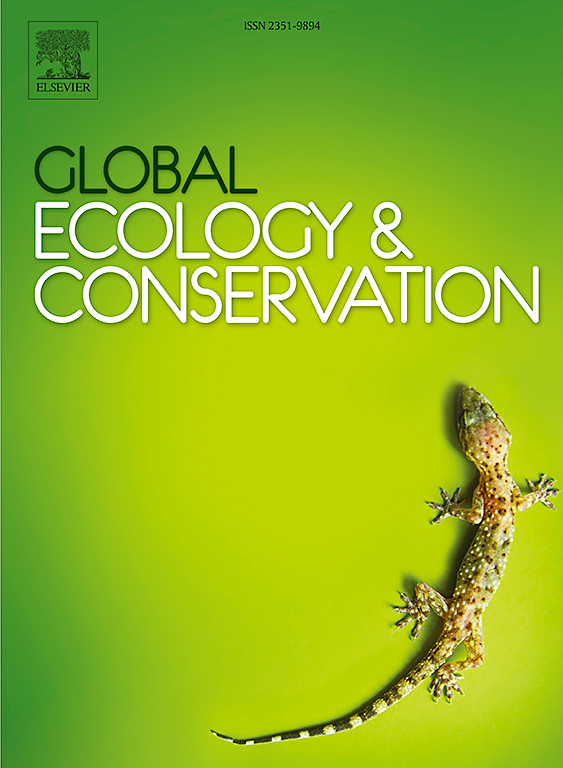Spatiotemporal patterns in sex ratios of bat fatalities at wind energy facilities in the United States
IF 3.4
2区 环境科学与生态学
Q1 BIODIVERSITY CONSERVATION
引用次数: 0
Abstract
A challenge facing bat conservation and wind energy development is how to maximize renewable energy production while minimizing impacts to bat populations. Reproductive-aged females are particularly important to dynamics and stability of bat populations due to their life history characteristics, but morphological sex identification methods have resulted in inaccurate reporting of sex ratios of fatalities at wind energy facilities. Our goal was to assess overall species-specific sex ratios of fatalities, and how those ratios varied by time and location. We used molecular techniques to determine the sex of 4445 carcasses of Brazilian free-tailed (Tadarida brasiliensis), evening (Nycticeius humeralis), hoary (Lasiurus cinereus), eastern red (Lasiurus borealis), northern yellow (Lasiurus intermedius), silver-haired (Lasionycteris noctivagans), and southern yellow (Lasiurus ega) bats found during turbine searches at 20 wind energy facilities in ten states in the United States between 2009 and 2022. Species composition and number of years of data varied by site. Overall, there were more fatalities of females than males for silver-haired and southern yellow bats, but not the other species. Brazilian free-tailed bat sex ratios were female skewed in late summer, whereas female skew occurred during portions of spring and summer/fall for eastern red bats, hoary, and silver-haired bats, and in spring and late fall for evening bats. In addition, spatial patterns in sex ratios existed for eastern red and hoary bats. The observed spatial and temporal patterns of fatalities can help target fatality reductions strategies to locations and times of year that maximize the conservation benefit of those actions.
美国风能设施中蝙蝠死亡率的时空格局
蝙蝠保护和风能开发面临的挑战是如何最大限度地提高可再生能源的生产,同时最大限度地减少对蝙蝠种群的影响。由于其生活史特征,育龄雌性对蝙蝠种群的动态和稳定性尤为重要,但形态学性别鉴定方法导致风能设施死亡的性别比例报告不准确。我们的目标是评估死亡率的总体特定物种性别比例,以及这些比例如何随时间和地点而变化。我们利用分子技术确定了4445具巴西无尾蝠(Tadarida brasiliensis)、夜蝠(Nycticeius humeralis)、灰蝠(Lasiurus cinereus)、东红蝠(Lasiurus borealis)、北黄蝠(Lasiurus intermedius)、银发蝠(Lasionycteris noctivagans)和南黄蝠(Lasiurus ega)的性别,这些蝙蝠是在2009年至2022年期间在美国10个州的20个风能设施的涡轮机搜索中发现的。物种组成和数据年数因地点而异。总体而言,银毛和南黄蝙蝠的雌性死亡率高于雄性,但其他物种的死亡率则没有。巴西无尾蝙蝠的性别比例在夏末出现雌性偏倚,而东部红蝠、白毛和银毛蝙蝠的性别比例在春夏/秋季部分时间出现雌性偏倚,夜蝠的性别比例在春秋后期出现雌性偏倚。此外,东部红蝠和灰蝠的性别比例存在空间格局。观察到的死亡的空间和时间模式可以帮助将减少死亡的战略确定在一年中的地点和时间,使这些行动的保护效益最大化。
本文章由计算机程序翻译,如有差异,请以英文原文为准。
求助全文
约1分钟内获得全文
求助全文
来源期刊

Global Ecology and Conservation
Agricultural and Biological Sciences-Ecology, Evolution, Behavior and Systematics
CiteScore
8.10
自引率
5.00%
发文量
346
审稿时长
83 days
期刊介绍:
Global Ecology and Conservation is a peer-reviewed, open-access journal covering all sub-disciplines of ecological and conservation science: from theory to practice, from molecules to ecosystems, from regional to global. The fields covered include: organismal, population, community, and ecosystem ecology; physiological, evolutionary, and behavioral ecology; and conservation science.
 求助内容:
求助内容: 应助结果提醒方式:
应助结果提醒方式:


